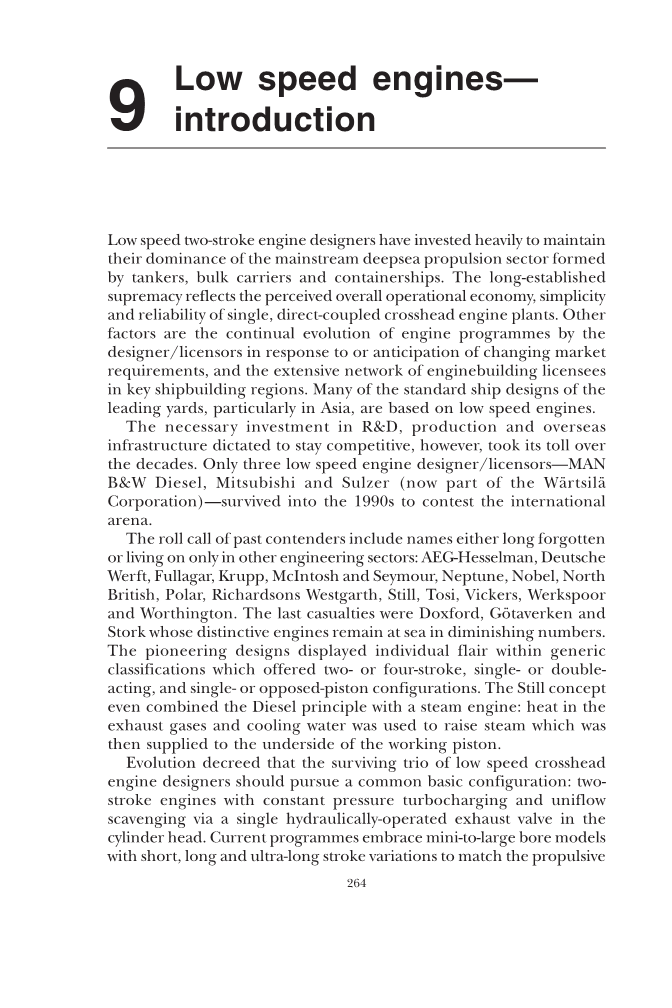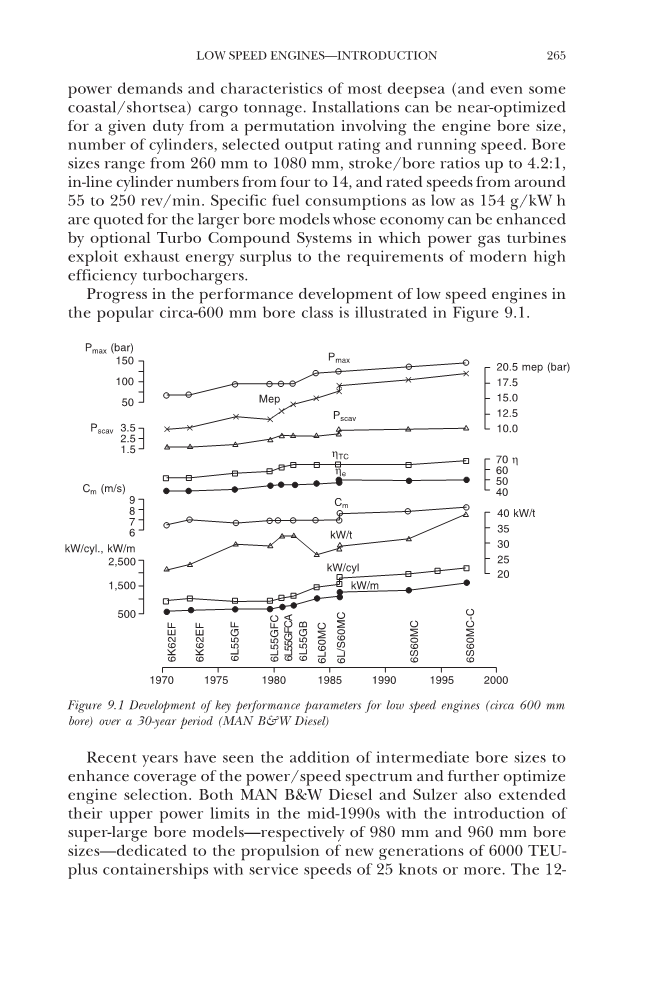

英语原文共 16 页,剩余内容已隐藏,支付完成后下载完整资料
|
英文原文 |
译文 |
|
Chapter 9 Low speed engines-introduction |
第九章 低速发动机介绍 |
|
Low speed two-stroke engine designers have invested heavily to maintain their dominance of the mainstream deepsea propulsion sector formed by tankers, bulk carriers and containerships. The long-established supremacy reflects the perceived overall operational economy, simplicity and reliability of single, direct-coupled crosshead engine plants. Other factors are the continual evolution of engine programmes by the designer/licensors in response to or anticipation of changing market requirements, and the extensive network of engine building licensees in key shipbuilding regions. Many of the standard ship designs of the leading yards, particularly in Asia, are based on low speed engines. |
低俗二冲程发动机的设计者们为了保持他们在由油轮、散货船和集装箱船组成的主流深海推进领域的主导地位,投入了巨额资金。单缸直联式十字头发动机工厂长期确立的优势反映了其整体运营的经济性、简单性和可靠性。其它因素包括:设计者或特许商为预见和响应市场需求的变化而不断改进发动机方案,以及在主要造船地区,需要拥有 “特许制造商”关系网,而这些制造商必须持有发动机建造执照。许多领先船厂的标准船舶设计,都是基于低速发动机的,这一点在亚洲尤为突出。 |
|
The necessary investment in Ramp;D, production and overseas infrastructure dictated to stay competitive, however, took its toll over the decades. Only three low speed engine designer/licensors—MAN Bamp;W Diesel, Mitsubishi and Sulzer (now part of the Wauml;rtsilauml; Corporation)—survived into the 1990s to contest the international arena. |
数十年来,为了保持竞争力,很多企业在研发、生产和海外基础设施方面付出了必要的投资。但是只有三家低速发动机设计商和特许商——MAN Bamp;W Diesel, Mitsubishi和Sulzer(现在是Wauml;rtsilauml; a公司的分部)——存活到20世纪90年代,在国际舞台上竞争。 |
|
The roll call of past contenders include names either long forgotten or living on only in other engineering sectors: AEG-Hesselman, Deutsche Werft, Fullagar, Krupp, McIntosh and Seymour, Neptune, Nobel, North British, Polar, Richardsons Westgarth, Still, Tosi, Vickers, Werkspoor and Worthington. The last casualties were Doxford, Gouml;taverken and Stork whose distinctive engines remain at sea in diminishing numbers. The pioneering designs displayed individual flair within generic classifications which offered two- or four-stroke, single- or double acting, and single- or opposed-piston configurations. The Still concept even combined the Diesel principle with a steam engine: heat in the exhaust gases and cooling water was used to raise steam which was then supplied to the underside of the working piston. |
过去竞争者的名册中包括长期被遗忘或仅在其他工程领域中使用的名称:AEG-Hesselman, Deutsche Werft, Fullagar, Krupp, McIntosh and Seymour, Neptune, Nobel, North British, Polar, Richardsons Westgarth, Still, Tosi, Vickers, Werkspoor和Worthington.最后的受损是Doxford, Gouml;taverken和Stork,他们独有的发动机数量还在不断减少。这些开创性的设计在通用分类中展示出独特的风格,可提供二冲程或四冲程,单作用或双作用以及单活塞或对置活塞配置。斯蒂尔的学说甚至将柴油机原理与蒸汽机相结合:利用废气中的热量和冷却水来产生蒸汽,然后将蒸汽供应到工作活塞的底部。 |
|
Evolution decreed that the surviving trio of low speed crosshead engine designers should pursue a common basic configuration: two-stroke engines with constant pressure turbocharging and uniflow scavenging via a single hydraulically-operated exhaust valve in the cylinder head. Current programmes embrace mini-to-large bore models with short, long and ultra-long stroke variations to match the propulsive power demands and characteristics of most deepsea (and even some coastal/shortsea) cargo tonnage. Installations can be near-optimized for a given duty from a permutation involving the engine bore size, number of cylinders, selected output rating and running speed. Bore sizes range from 260 mm to 1080 mm, stroke/bore ratios up to 4.2:1, in-line cylinder numbers from four to 14, and rated speeds from around 55 to 250 rev/min. Specific fuel consumptions as low as 154 g/kW h are quoted for the larger bore models whose economy can be enhanced by optional Turbo Compound Systems in which power gas turbines exploit exhaust energy surplus to the requirements of modern high efficiency turbochargers. |
不断的发展决定了幸存的三家低速十字头发动机设计商应该采用一种通用的基本配置:在二冲程发动机上,采用恒压涡轮增压和通过气缸盖上的液压控制的排气阀进行单流量扫气。目前的项目采用从小到大的孔径模型,具有短、长和超长等不同冲程,能够满足大多数深海(甚至一些沿海/近海)货物吨位推进动力的需求和特性。根据发动机的内径尺寸、气缸数量、选定的额定输出功率和运行速度,可以对给定的负载进行近似优化。缸径尺寸范围从260毫米到1080毫米,冲程缸径比达到4.2:1,缸数从4到14,额定转速从55到250转/分钟。大口径型号的燃油消耗率低至154g/kW·h,其经济性还可以通过可选的涡轮复合系统来提高,在该系统中,动力燃气轮机利用废气中的剩余能量来满足现代高效涡轮增压器的要求。 |
|
Progress in the performance development of low speed engines in the popular circa-600 mm bore class is illustrated in Figure 9.1. |
图9.1描述了目前流行的大约600毫米内径级低速发动机性能发展的进展情况 |
|
Recent years have seen the addition of intermediate bore sizes to enhance coverage of the power/speed spectrum and further optimize engine selection. Both MAN Bamp;W Diesel and Sulzer also extended their upper power limits in the mid-1990s with the introduction of super-large bore models—respectively of 980 mm and 960 mm bore sizes—dedicated to the propulsion of new generations of 6000 TEUplus containerships with service speeds of 25 knots or more. The 12- cylinder version of MAN Bamp;Wrsquo;s current K98MC design, delivering 68 640 kW, highlights the advance in specific output achieved since the 1970s when the equivalent 12-cylinder Bamp;W K98GF model yielded just under 36 800 kW. Large bore models tailored to the demands of new generation VLCC and ULCC propulsion have also been introduced. |
近年来,为了提高功率和速度频谱的覆盖范围和进一步优化发动机的选择,增加了中间孔的尺寸范围。在20世纪90年代中期,MAN Bamp;W Diesel和Sulzer都扩大了功率上限,推出了分别具有980毫米和960毫米的超大口径型号发动机,这些发动机将用在新一代6000TEUplus集装箱船上,使船速能够达到25节或以上。 目前MAN B&W生产的12缸版本的K98MC发动机可提供68640 kW的功率,这突显了自20世纪70年代以来等效输出的进步,在当时,同样12缸版本的 B&W K98GF型号发动机产生的功率低于36800 kW。同时还推出了适合新一代VLCC和ULCC推进要求的大口径型号发动机。 |
|
Successively larger and faster generations of post-Panamax containerships have driven the development of specific output and upper power limits by low speed engine designers. To ensure that containership designs with capacities up to 剩余内容已隐藏,支付完成后下载完整资料 资料编号:[238282],资料为PDF文档或Word文档,PDF文档可免费转换为Word |


